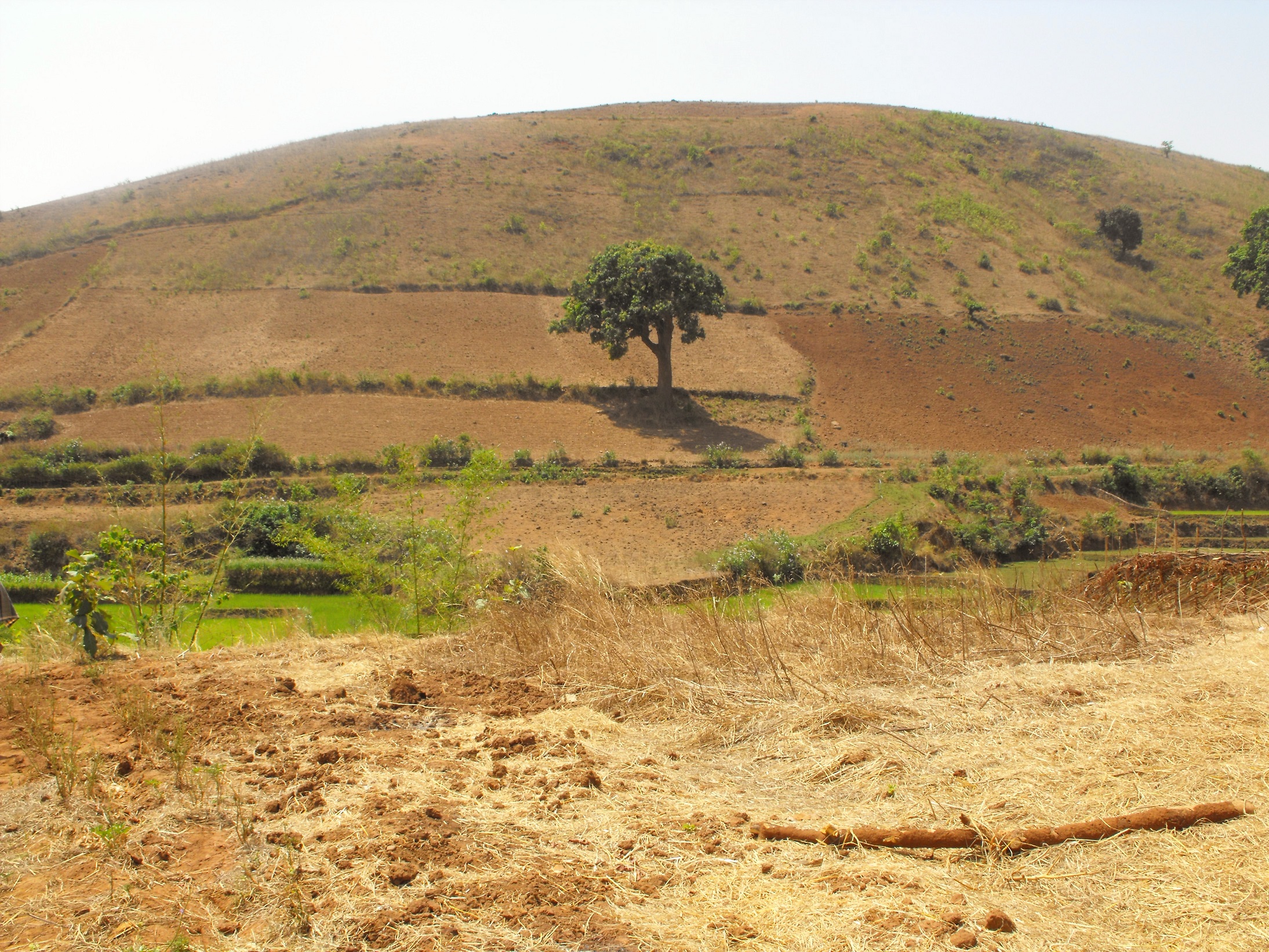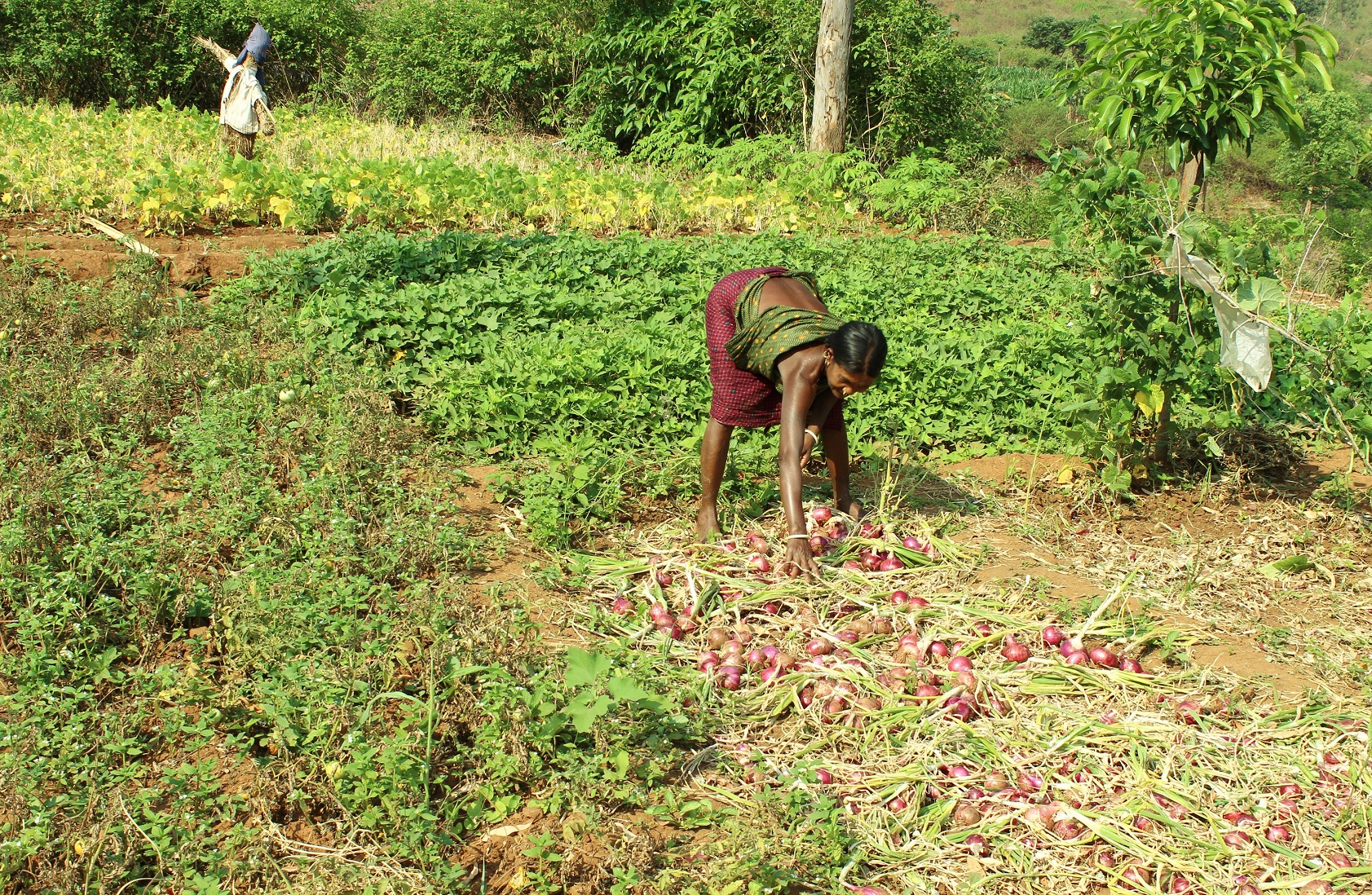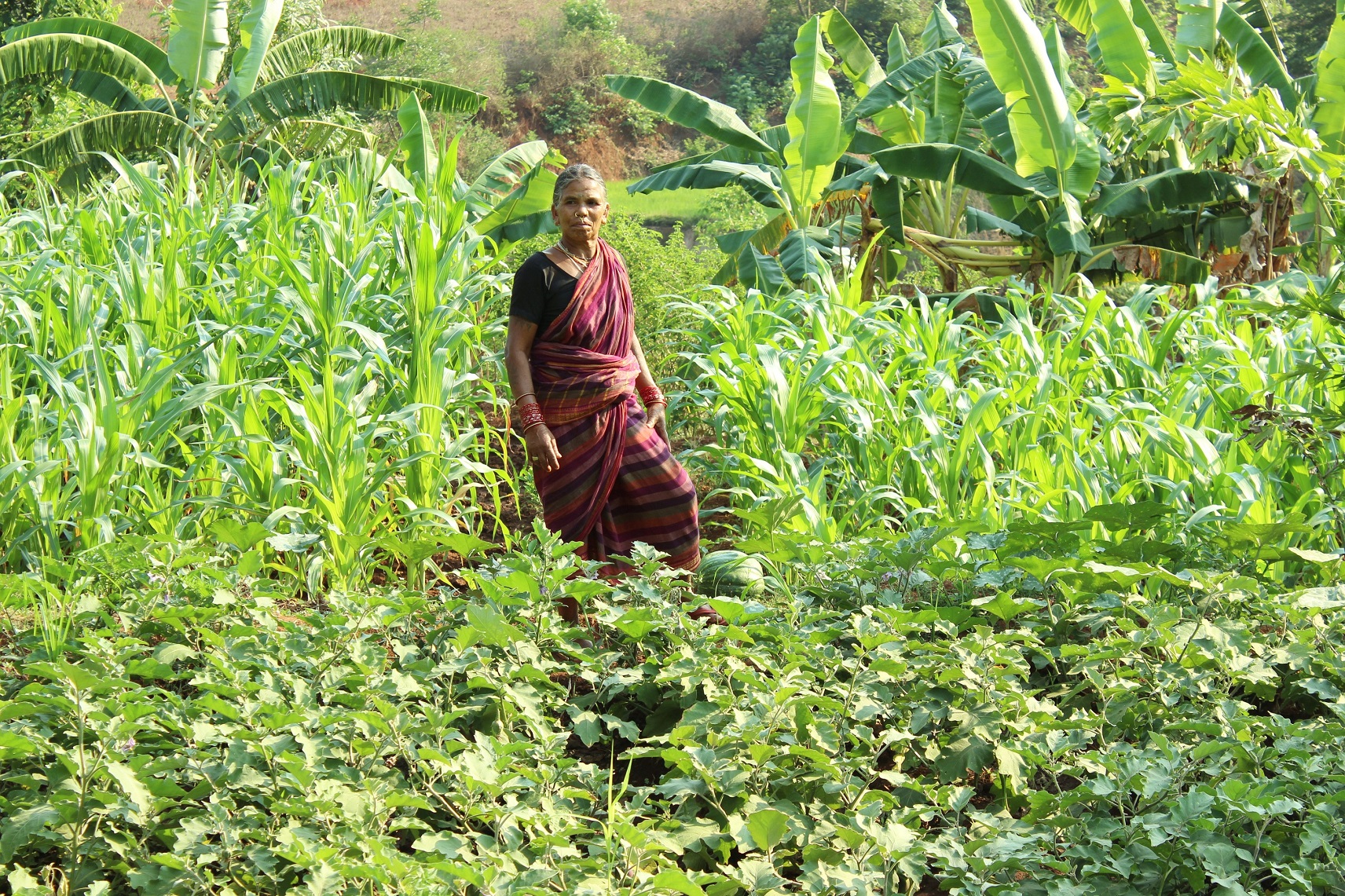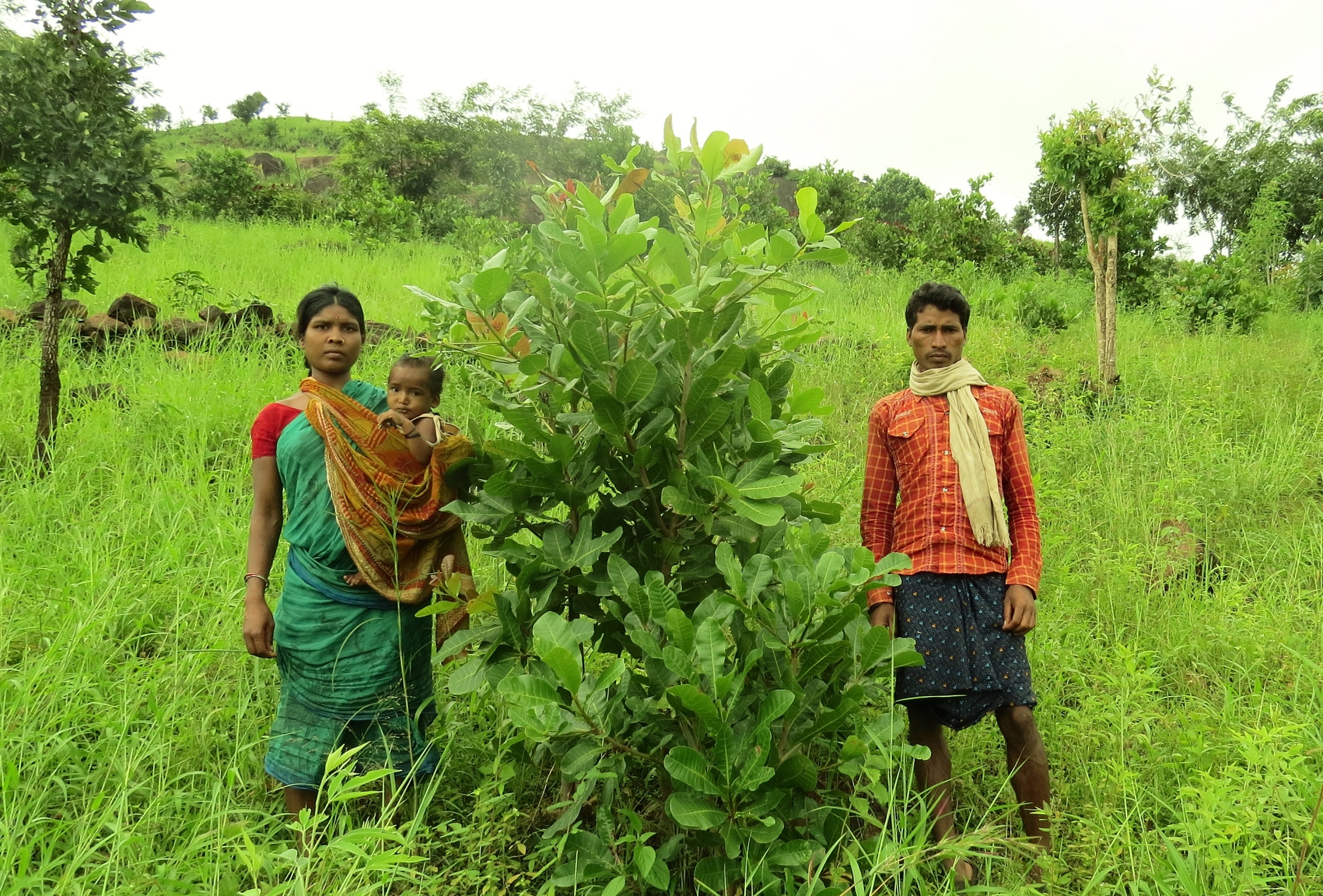In southern Odisha State, India, the landscape and livelihoods of the indigenous family farmers are seriously threatened by industrial agriculture, bauxite mining, large dams, changing rainfall patterns and government apathetic attitude. But, indigenous communities have decided how they want to conserve their land for their own benefit. And they are doing it successfully.
“Five years ago, we lived a miserable life as farm laborers because there were not much of work opportunities. And, as agriculture didn’t remain feasible or a reliable occupation, we had to borrow money from the Sahukar (local moneylender) more often and all our efforts were to repay the money with exorbitant rate of interest. Life was really difficult then. There was absolutely no hope but just to struggle to make a living”, Adbari Majhi recalling her difficult days of the past.
The case of Adbari represents the pitiable situation of many women farmers of Kashipur block of Odisha in India. The region is widely known for poverty, hunger and malnutrition. Kashipur is a hilly and forested region predominantly inhabited by the Paraja, Kondho indigenous communities who are primarily agrarian and practice podu chasa (shifting cultivation) on the hill slopes since generations.

Sifting cultivation – a major reason for soil erosion and diminishing yield in Kashipur, Pic: Abhijit Mohanty
Agriculture remained reliable till forest cover was intact to check flash floods and soil erosion, the rain was timely and climate was conducive. As forests depleted to make space for developmental works and, also, to support the household, commercial and industrial needs of timber, the local climate and rain pattern changed. Increasing events of extreme rain, while causing flash floods, frequently washed down the loose soil of the cultivated lands on the hill slopes causing damage to the farms on the hilly slopes and the plane lands at the bottom of the hills.
“Rains have been delayed by almost a month and the length of the crop season has decreased to only three months, which has to be about five months for agriculture. Again, it’s less rain or heavy rain. Anyway, it damages crop,” says Balsingh Majhi, a young farmer of Dandabad village.
“We incurred loss every year as nature and climate betrayed continuously for years together. Our financial condition was so bad that I even couldn’t afford the treatments of my husband who died of prolonged illness a few years back,” said Jaimati Majhi (40) of Dandabad.
As climate change made agriculture unreliable, there was less income and growing food insecurity, which deterred the youth from taking up farming as profession, and distress migration started in these villages. Change in seasonal cycle has been a factor as well. “While late rain delays field activities for cultivation of ragi, a major crop in the region, early winter comes as the next enemy to kill the harvest,” farmers of the whole region complain.
Vidhya Das, Joint Director, who runs an NGO called Agragamee in the region and possess decades of development experience shares “in the present society, the community depends mainly on the forest and on rainfed agriculture. So we found that over the years, the forest land has decreased and they are bringing more and more area under shifting cultivation where people move from one patch to another in every 2-3 years and the cycle becomes larger and larger. And the production has diminished. This also leads to climate change as the large scale burning under shifting cultivation adversely affects the environment and triggers soil erosion negatively affecting the valley bottom land by increasing siltation.”
Take for instance Jaimati Majhi, a woman farmer of Dandabad village. She recalls that “earlier, we were getting proper rain, enough water and good summer. Now, the summer is disturbed. Water has become scarce. How can we expect a good harvest? What shall we eat?”. “In the last 10 years, people were self-reliant, people have not even heard about migration slowly out because of the diminishing returns from the land, the migration rate has increased three to four times. Almost in every village, on an average 15-20 people are migrating out of the State for sustaining their livelihood”, stressed Vidhya. “Some of them even die at their workplace. Last year, two youth of Maligaon village died in Andhra Pradesh (neighbouring State of Odisha)”, mournfully says Sumani Jhodia of Siriguda village, a community leader and the president of Ama Sangathan.
Collective initiative shows the way
It is in this situation, Agragamee and Ama Sangathan, two Non-Government Organisations working for socio-economic empowerment and holistic development of women and tribal communities in the Kashipur Block collectively conceptualized the idea of developing Eco-village. With the support of Indigenous People Assistance facility (IPAF), Rome, the idea of developing Eco-village was eventually translated into practical action at the village level. Vidhya says, “in this hilly terrain, we have to think on the way where there will be soil conservation and where people could produce their own food on a sustainable manner and also have a better income”.

Adbari Majhi in her family farm inter-cropped and mixed-cropped of vegetables, pulses, millets with orchard spices, she is sun-drying harvested onions, Pic: Abhijit Mohanty
“For the last two years, as we have been practicing mixed-cropping and inter-cropping pattern of farming in our family farm and the community land on the hill slopes, life seems to be changing for better now. I have grown maize, brinjel, tomato, chili, cauliflower, chickpea and beans. Apart from vegetables crops, I have also planted mango, cashew, banana and papaya in the farm that has a vegetative fence,” Adbari said while showing her farm excitedly.
Now, with her husband and son, Adbari lives a better life as the new way of farming has not only been reliable but has increased her income as well motivating her son to pursue farming as the main profession instead of moving out of village in search of job. The change that has come in the lives of Adbari and hundreds of women has been the result of adopting Eco-village model of farming.
The Eco-village model
We are hoping that if we start developing land of individual family farm and help them also to develop their common land (barren land used for community purposes since generations by the villagers) in the similar manner, there will be a larger impact on the landscape of the village. The individual family farmers will be encouraged to design 0.4 hectare of land into partly income generating area through planting orchard spices and partly producing subsistence indigenous food crops. With this, the farmer will have ample food crop so they will have food security, and they will get income by selling the surplus produces. In this way they will be able to develop further areas as well.
Similarly, taking examples from commons, the farmers will also protect other areas of commons in the village. And then because they are able to have enough food and income security from their farms, they will allow the jungle to regenerate in other areas too. So there will be a multiple kind of eco-system rejuvenation where forest, agriculture, and income generating orchard spices are combined together will ensure a better livelihood. This will eventually lead to a more integrated system of sustainable farming which we call Eco-village development. “One of the unique features of the project was that the traditional knowledge of the community was highly respected and trainings were imparted for best use of it,” says Vidhya.
Regenerating and rejuvenating common lands
Mahila Mandals or the village Women Groups were encouraged to take up community farming on the land of the commons to create a resource of the community to support its individual members in time of distress. This has yielded many success stories.
Take fore instance of Rukmini Majhi of Yugbasa Kebidi village, she shares that “staffs of Agragamee aware us how development of commons would change our lives. We have planted saplings of mango, cashew provided by them. They provided us the seeds to raise nursery of various forest spices also. Soon the saplings were ready, we planted them in our common land”. When the author asked Rukmani what will they do with the produces from the common lands; Rukmani fervently replied that, “we will use the chakunda (Foetid Cassia) trees to meet our fire-wood needs. Oil extracted from karanj (Pongamia Pinnata) seed will be used as edible oil. The mango and cashew nuts will give us a better income. The produces from the commons will be equally distributed among all the members of the Mahila Mandal. We hope for a better life and a better income from our common lands. This will open up new opportunity for our survival with dignity. We never did it before. But, yes, we are doing it now”.

The denuded common land has been rejuvenated by of the Yugbasa Kebidi Mahila Mandal through plantation of cashew, mango and many forest spices, Pic: Abhijit Mohanty
“They took up the challenge with courage and conviction. We only stepped in with support for fencing, tree seeds and seedlings, nursery equipment and capacity building for better implementation of the project and management of the commons,” says Vidhya.
Development of family farms
“Earlier, it was only a hilly shrubby patch” says Jaimati Majhi of Dandabad village. “I have made it my garden and raised a live fence of nagri (Lippia Javancia) around the farm to protect the crops from cattle grazing. I grow a range of millets like finger, pearl, kodo, barnyard, little and pulses like pigeonpeas, chickpeas with tubers, leafy vegetables and mango, cashew and guava here” excitedly shares Jaimati. Similarly, Baidi Majhi of Maligaon village shares that she cleaned the area and then planted mango saplings. She planted banana and other fruit saplings in her farm. She further shares that, “it was a life of scarcity. But now, it is much better life. We, now, make a survival out of the farm by selling the surplus vegetable produces at the local markets”.
The communities have effected a little modification to erstwhile way of farming as an adaptation to the changing climate though it is largely based on the knowledge these communities inherit through generations of practice. And, quite amazingly, this has changed agriculture from an unreliable source of livelihood to an economic activity with new opportunities. From developing the land for agriculture to raising the farm, women took the lead as was the basic objective of the eco-village development.

Sumani Jhodia visiting a family farm of Durukhal village, intercropping and mixed-cropping of maize, brinjel, pumpkin, banana, pulses, Pic: Abhijit Mohanty
Perceptible impacts
Since the village farmers have taken up this eco-friendly farming practice, it has almost completely replaced shifting cultivation in those villages and other neighbouring villages as well. Although it’s a fact that such plantation of income generating and firewood trees cannot compensate the loss of natural forest that has already taken place in the region to meet the industrial demands, this is certainly a positive step to check soil erosion and conserve the ecosystem.
And, there is no doubt that the farmers are now seeing agriculture as a reliable and viable livelihood option. As the farmers are practicing organic farming; using farm yard manures and applying organic insecticides, the natural fertility of the soil is also increasing. There has been improvement in economic condition of the farmers and food security of the communities. We are slowly seeing that farmers are also catching the idea and reviving back mixed-cropping, they are integrating the permanent crops with annual seasonal crops. Lot of farmers are learning the value of live fencing which usually protects the plot from cattle grazing and provide fire-wood and fodder.
The success achieved by the project and the change that has come in the lives of especially the women farmers during these three years of implementation makes it an alternative model of development through eco-friendly agriculture and proper management of the commons.
In view of the fact that climate change and ecological degradation have become global concerns, such models need to be replicated widely, at least in the hilly tropical and sub-tropical regions as measures for ecosystem conservation and climate change adaptability.

Kuntala Majhi with her child and husband in their family farm, mixed-cropping of millets and pulses with orchard spices, Pic: Abhijit Mohanty
Author: Abhijit Mohanty is a development professional based in Odisha, India and works for Agragamee. He holds a MBA in Rural Management from AMITY University, India. His works has been regularly published in India Together and LEISA India.
Email: abhijitmohanty10@yahoo.com

There is no alternative to such land use pattern; call it eco-farming, smart agriculture (catch words used in Africa). Safe way to survive but impossible to grow (without scale, cost from farm gate). Back to basics for the indigenous. These categories with unstoppable & unforeseen adversities can find out survival paths through their innate skills. Revival of foster forests in short time length is impossible. The modern theory will make them poorer to poorest. Do not plan mainstreaming them.
Dear Gopi Srichandan
I sincerely request you to share your ideas and experience to revive and regenerating already fragile eco-system especially in the rain-fed areas. If you have proven models which have been tested and validated than please do share them. And your suggestion regarding not to mainstream them, it is to inform you that we have been replicating the model in around 2000 acres of land in 4 districts of Odisha and it has shown positive results. You can plan a visit to the field and interact with the farmers.
Do provide these rural inhabitants with an understanding of market. Specially focusing on the market of Bop. Tell them how does it functions without market livelihood is meaningless affair.
Dear Swaroop
You have raised a very relevant and important aspect. We are in the process of formation and registration of Farmers Producer Company (FPCs) constituting of farmers as its members, FPCs will enable better bargaining and negotiating skills amongst the tribal farmers.